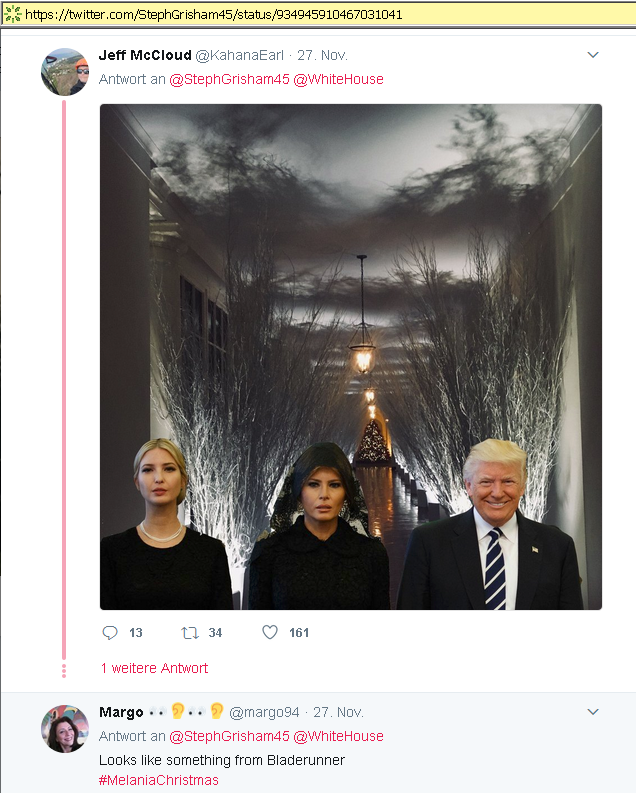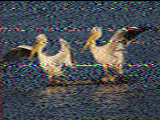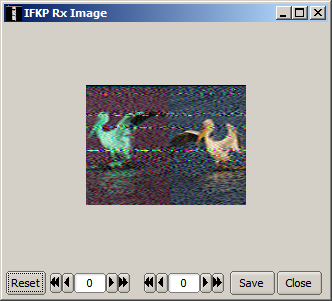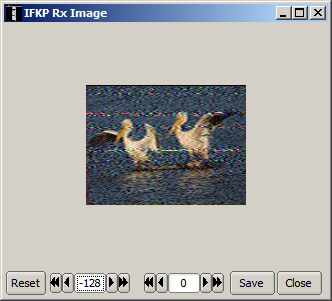http://www.rhci-online.net/radiogram/radiogram.htm

|
RSID: <<2017- 12-01T02:25Z
MFSK-32 @
WRMI SYSTEM B 9955000+1488>>
START
IBC - ITALIAN BROADCASTING CORPORATION
mail: ibc@europe.com
http://www.ibcradio.webs.com
FB: @ITALIANBROADCASTINGCORPORATION
TW:
@RADIOIBC
"IBC DIGITAL" "IBC DIGITAL"
===========================
*** 4 2 5 D X N E W S ***
**** DX INFORMATION ****
===========================
Edited by I1JQJ & IK1ADH
A3 - Hiro, JA6WFM has been active as A31MM from Nuku'alofa (OC-049),
Tonga since January 2016, and will QRT at the end of
the year. This
weekend's CQ WW DX CW will be the last contest for him;
after that
he will be QRV on 15 metres only. QSL via LoTW or
direct to EA5GL.
C5 - Andre, ON7YK has been active again as C5YK since 17 November, and
will remain in The Gambia until 30 January 2018. He
operates
digital modes (especially FT8) and some CW on 40, 20,
17 and 15
metres. QSL via LoTW and eQSL, or via home call (direct
or bureau).
Logsearch on
http://www.on7yk.eu/.
C6 - Tomi HA7RY, George AA7JV and Michael KN4EEI have been active as
C6AGU from Water Cay (NA-001), Bahamas since 19
November and will
remain there until 3 December, including activity
during the ARRL 160 Meter Contest.
While operating mainly CW and some SSB on 160-10 metres,
they will test some new
antennas (a 43-foot vertical for 160/80/40m, a
2-element yagi
vertical for 20-10m, and a 4-square RX antenna) for the
2018
DXpedition to Baker Island (KH1). QSL via HA7RY;
neither Club Log
nor LoTW will be used.
H40 - Cezar, VE3LYC plans to be active from Taumako Island (OC-179),
Temotu for at least five days in early May 2018. This
Most Wanted
IOTA group was activated only once, by H44MS (DL2GCA)
back in March
1993. Complete information is expected in due course. [TNX
DX News]
HC8 - HC8LUT (not HC8LU as previously announced) is the callsign issued
for the Argentine team [425DXN 1377] to use during
their activity
from San Cristobal, Galapagos Islands (SA-004) between
29 November
and 8 December. They will operate SSB and digital modes
on 160-6
metres. QSL via IK2DUW and LoTW, logsearch on Club Log.
See
https://hc8lu.blogspot.com/ for more information.
HL - Celebrating the XXIII Olympic Winter Games that will be held next
year in PyeongChang (https://www.pyeongchang2018.com/en),
special
event station HL0WOP is active until 25 February 2018.
QSL via Club
Log's OQRS, eQSL, or via HL4CCM (direct or bureau).
HS - Look for E20WXA/p, HS2AAW/p and HS2JQC/p to be active from Koh Lan
(AS-107) on 25-26 November. QSL via E20WXA. [TNX The
Daily DX]
"IBC DIGITAL" "IBC DIGITAL"
END END |
http://www.425dxn.org/
The Italian Weekly Bulletin for Serious
DXers
..:: The 425
DX News Story ::..
425 DX News originates from a
group of local amateurs (the so-called '425 DX Gang') who used to meet
on 145.425 MHz and exchange DX information.
At a certain point 2 metres did not suit any more: many people living
far from call area 1 wanted to participate in the exchange, so that the
Gang moved on the HF bands (10 metres at first, then 80 metres) and
organized a weekly info net for Italian DXers.
In the early nineties, as Packet Radio got a footing and the Packet
Cluster Network links became more and more reliable, a bulletin in
writing was born. It was called 425 DX News in memory of the frequency
where everything had started from.
Between May 1991 and March 1995 the bulletin was sent in Italian
language on the BBS and PCL networks. On entering the Internet era, a
website and a mailing list were created, and 425 DX News began being
produced in English. In 2005 it became the DX Bulletin of ARI, the IARU
member society for Italy.
In June 2010 the mailing list [425eng] moved to Google Groups, and has
been administered by Stefano Turci, IK4WMH since then.
425 DX News is also available on other mailing lists such as Yahoo
Group's [DX IS], and in other languages (for instance in Russian,
translated by Alexander Venderovich, UA9MHN).
Complementary to 425 DX News are the 425 Magazine, initiated by Maurizio
Bertolino (I1-21171) and continued by Nicola Baldresca (IZ3EBA), and the
popular piece of software developed by Leonardo Lastrucci (IZ5FSA),
which allows to query the 425DXN Archive from the PacketCluster and on
the Web.
In May 2007 the Editors of 425 DX News were inducted into the CQ DX Hall
of Fame, "in recognition of their extraordinary and unselfish
contribution to the sport of Amateur Radio DXing".
Mauro Pregliasco, I1JQJ
Valeria Pregliasco, IK1ADH
|



RSID: <<2017-12-02T16:01Z MFSK-32
@ 94000000+1500>>
Welcome to program 24 of Shortwave Radiogram.
I'm Kim Andrew Elliott in Arlington, Virginia, USA.
Here is the lineup for today's program, all in MFSK32:
1:29 Program preview (now)
2:37 Ocean's deepest fish*
10:47 Could we run out of sand?*
19:21 Russia looks into separate internet for BRICs*
23:24 Sun's activity steady during solar minimums*
26:50 More SSTV from the ISS
28:07 Closing announcements
* with image
Please send reception reports to radiogram@verizon.net
And visit http://swradiogram.net
Twitter:
@SWRadiogram
From Futurity.org:
Ocean's deepest fish thrives 26,000 feet below surface
Michelle Ma
29 November 2017
The ocean's deepest fish doesn't look like it could survive in
harsh conditions thousands of feet below the surface. Instead of
giant teeth and a menacing frame, the fishes that roam in the
deepest parts of the ocean are small, translucent, bereft of
scales-and highly adept at living where few other organisms can.
The Mariana snailfish (Pseudoliparis swirei) that thrives at
depths of up to about 8,000 meters (26,200 feet) along the
Mariana Trench near Guam is named after a sailor, Herbert Swire,
an officer on the HMS Challenger expedition in the late 1800s
that first discovered the Mariana Trench.
"This is the deepest fish that's been collected from the ocean
floor, and we're very excited to have an official name," says
lead author Mackenzie Gerringer, a postdoctoral researcher at the
University of Washington's Friday Harbor Laboratories. "They
don't look very robust or strong for living in such an extreme
environment, but they are extremely successful."
Snailfish are found at many different depths in marine waters
around the world, including off the coast of San Juan Island. In
deep water, they cluster together in groups and feed on tiny
crustaceans and shrimp using suction from their mouths to gulp
prey. Little is known about how these fish can live under water
pressure that can be as intense as an elephant standing on your
thumb.
As reported in Zootaxa, the new species appears to dominate parts
of the Mariana Trench, the deepest stretch of ocean in the world
that is located in the western Pacific Ocean. During research
trips in 2014 and 2017, scientists collected 37 specimens from
depths of about 6,900 meters (22,600 feet) to 8,000 meters
(26,200 feet) along the trench. DNA analysis and 3D scanning to
analyze skeletal and tissue structures helped researchers
determine they had found a new species.
Since then, researchers from Japan recorded footage of the fish
swimming at depths of 8,178 meters (26,830 feet), the deepest
sighting so far.
"Snailfishes have adapted to go deeper than other fish and can
live in the deep trenches. Here they are free of predators, and
the funnel shape of the trench means there's much more food,"
says coauthor Thomas Linley of Newcastle University. "There are
lots of invertebrate prey and the snailfish are the top predator.
They are active and look very well-fed."
A handful of researchers have explored the Mariana Trench, but
few comprehensive surveys of the trench and its inhabitants have
been completed because of its depth and location, Gerringer says.
These research trips, conducted while she completed her doctorate
at University of Hawaii at Manoa, involved dropping traps with
cameras down to the bottom of the trench. It can take four hours
for a trap to sink to the bottom.
After waiting an additional 12 to 24 hours, researchers sent an
acoustic signal to the trap, which then released weights and rose
to the surface with the help of flotation. That allowed
scientists to catch fish specimens and take video footage of life
at the bottom of the ocean.
"There are a lot of surprises waiting," Gerringer says. "It's
amazing to see what lives there. We think of it as a harsh
environment because it's extreme for us, but there's a whole
group of organisms that are very happy down there."
The Mariana snailfish's location is its most distinguishing
characteristic, but with the help of a CT scanner, researchers
also saw a number of differences in physiology and body structure
that made it clear they had found a new species.
Alan Jamieson of Newcastle University, and Erica Goetze and
Jeffrey Drazen of the University of Hawaii at Manoa are coauthors
of the paper. The National Science Foundation, Schmidt Ocean
Institute, and the Marine Alliance for Science and Technology for
Scotland funded the work.
Source: University of Washington
http://www.futurity.org/mariana-snailfish-oceans-1616252-2/
Image: A CT scan of the Mariana snailfish, showing the frontal
head. ...
Sending Pic:206x173C;

This is Shortwave Radiogram.
Please send reception reports to radiogram@verizon.net
From Deutsche Welle:
Could we run out of sand?
Sand seems to be in limitless supply - but we are going
through it faster than almost any other resource on the
planet. What happens when the sand runs out?
Harald Franzen
27 November 2017
On parts of the shoreline in the Moroccan beach town of Tangier,
something is amiss. Though the ocean is there - its waves
lapping, crashing and roaring as they have since time immemorial
- it is not a place for long days of lazing on soft sand. Because
there isn't any.
Instead of a rolling golden strand, there is a rockscape with
lunar-like formations. Though spectacular to behold, they aren't
natural phenomena - but actually just former beaches stripped
bare by large-scale theft of sand.
But why steal it? "We have a lot of sand, but we also have a lot
of demand," Hermann Kessler from the German Environment Agency
(UBA) told DW.
It is used in many, many things. From toothpaste and plaster to
stone-washed jeans; crockery, kitchen sinks and toilet bowls;
from windows and beer bottles to silicon chips that are used in
items from smart phones to cars.
But by far the biggest consumer is the construction industry,
which uses sand to produce bricks, asphalt and concrete. It takes
around 200 tons (400,000 pounds) of the stuff to make a mid-sized
house; to build a kilometer of highway takes 30,000 tons; and a
nuclear power plant around 12 million tons.
Construction consumes huge amounts of sand. A single kilometer of
highway requires 30,000 tons
A recent report by the United Nations Environmental Programme
(UNEP) estimated the annual global consumption of sand and gravel
to exceed 40 billion tons.
"Sand is a fossil resource," said researcher Kiran Pereira, who
founded sandstories.org to raise awareness of the issue. "It
takes millions of years to form - but a mine can be exhausted in
decades," she pointed out.
"We need to recognize and value the ecosystem services provided
by sand, many of which are irreplaceable."
Construction, corruption and crime
How critical the situation is varies greatly from location to
location.
"We won't be running out of sand here in Germany," said Kessler,
who is responsible for resource conservation at UBA. "But
globally, it's a very different story."
The biggest sand importer in the world is Singapore. In the past
40 years, the small and crowded island has used large-scale land
reclamation - a process that entails filling in shallow waters to
be able to build on them - to expand by its land mass by 130
square kilometers (about 50 square miles). That practice requires
vast quantities of sand.
There was a time when much of it came from nearby Indonesia,
Malaysia, Vietnam and Cambodia - but all four countries have now
banned Singapore from exporting their beaches. This has pushed
sand's metric ton price up from €2.55 (3.00 dollars) to €161. And
that increase has had impact.
"The sand business is very corrupt," Kessler said, adding it is
often conducted illegally, and is done by people who "don't shy
away from threats and even murder."
Criminal gangs are stealing sand in countries ranging from
Jamaica to Nigeria. India even has a sand mafia, known for its
ruthlessness.
Some gangs will drive onto a beach with excavators and large
trucks and help themselves to as much as they can in a single
night - while others use simple hand tools to fill bags they load
onto mules to take directly to nearby construction sites.
Another method of extraction is to use suction dredge barges,
which act like giant vacuum cleaners that suck up the sand from
the ocean floor in shallow waters. This wreaks havoc on the ocean
floor. ...
No easy fix
There is no silver bullet to solve this problem, though there are
various efforts underway to find alternatives.
Two German entrepreneurs are currently experimenting with desert
sand, which in a twist of irony - given that the oil-rich
countries of the Persian Gulf region are among the biggest
importers - is too wind-polished to use in concrete.
Though it's still early days, they have found a way to combine
smooth desert grains with synthetic resin to create polymer
concrete, which is even more durable than its conventional
counterpart.
In light of environmental problems around building with concrete,
there's also concrete recycling - but for that to make economic
and environmental sense, there needs to be enough old concrete
close to the new construction site. ...
Full text:
http://www.dw.com/en/could-we-run-out-of-sand/a-41559422
Sending Pic:222x124C;
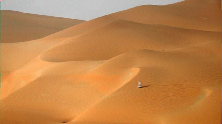
This is Shortwave Radiogram.
Please send reception reports to radiogram@verizon.net
From Meduza.io:
Russia's Security Council tells the government to develop a
separate Internet for the BRICS
28 November 2017
Russia's Security Council has instructed the Communications
Ministry and Foreign Ministry to develop plans for a separate
Internet infrastructure that would serve the five major "emerging
national economies" (Brazil, Russia, India, China, and South
Africa), known as "the BRICS." According to the magazine RBC,
Russia's Security Council discussed the initiative at a meeting
on October 26, and President Putin ordered the government to draw
up a proposal by August 1, 2018.
According to the Security Council's initiative, the BRICS would
create their own system of "duplicate domain name root servers,"
supposedly in order to guard against "offensive operations in the
information space" by Western countries, where the world's core
Internet infrastructure is based.
Experts told RBC that migrating to a duplicate copy of the
Internet's domain name root servers would effectively lead to the
creation of an alternate and separate Internet, fracturing the
World Wide Web.
-- Since 2014, Russian officials have conducted exercises to test
the sustainability of the Russian Internet, in the event that
Russia is disconnected from the World Wide Web. In these tests,
Russia's duplicate servers for the .RU and .?? domains have
functioned successfully.
-- In 2016, the Internet Corporation for Assigned Names and
Numbers (ICANN) and the Internet Assigned Numbers Authority
(IANA) were freed from oversight by the U.S. Department of
Commerce. These two nonprofit organizations are responsible for
coordinating the maintenance and procedures of several important
databases related to the namespaces of the Internet. Moscow has
repeatedly called on other emerging economies to endorse
initiatives to weaken the U.S. government's control over the
coordination and maintenance of the Internet.
http://bit.ly/2zC11oG
Sending Pic:224x66C;

This is Shortwave Radiogram.
Please send reception reports to radiogram@verizon.net
From VOA Science World Blog:
Sun's Activity Steady during Solar Minimum
Rick Pantaleo
24 November 2017
Scientists have learned, over many years, that the Sun goes
through a roughly 11-year cycle of being active to less active.
When the sun is most active with a growing number of sunspots,
coronal mass ejections, and blasts of solar flares, this is
called a solar maximum.
And, when the sun becomes calmer with not as many sunspots and
solar activity this is called the solar minimum.
A new study from Japanese astronomers has determined that while
the degree of the Sun's activity varies during a solar maximum,
there was very little variation in activity for each solar
minimum observed for the last 60 years.
Studying microwave transmissions from the sun over the last five
cycles of solar minimums, the astronomers found the level of
microwaves has been the same each time, unlike during the solar
maximums.
http://bit.ly/2AJV658
http://bit.ly/2As2IbS
Image: Graph showing sunspot numbers and radio flux density 1960
through 2015 ...
Sending Pic:228x115C;
|
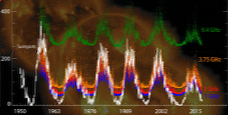
|
 |
From ARRL.org:
Slow-Scan TV Transmissions from ISS Scheduled for December 6-8
29 November 2017
ARISS has announced that the MAI-75 Slow-Scan (SSTV) system in
the Russian Service Module of the International Space Station
(ISS) will be on the air starting on December 5 at around 1500
UTC and continuing until December 6 at 0900 UTC, transmitting
test images on 145.800 MHz FM that should be available worldwide.
SSTV activity on December 7 and 8 is scheduled to occur at times
when the ISS is above Moscow. In the past images have been sent
in PD180 mode, with a 3-minute off time between each image.
http://www.arrl.org/news/slow-scan-tv-transmissions-from-iss-scheduled-for-december-6-8
See also:
https://ariss-sstv.blogspot.com/
Transmission of Shortwave Radiogram is provided by:
WRMI, Radio Miami International, http://wrmi.net
and
Space Line, Bulgaria, http://spaceline.bg
Please send reception reports to radiogram@verizon.net
And visit http://swradiogram.net
Twitter:
@SWRadiogram
I'm Kim Elliott. Please join us for the next Shortwave
Radiogram.
|
Ending song:
Vince Guaraldi Trio -
O Tannenbaum
|
Program
24S of Shortwave Radiogram
RSID: <<2017-12-03T23:30Z
MFSK-16
@ 11580000+1500>>
Welcome to program 24S of Shortwave Radiogram.
This special broadcast is in three slow modes that may provide
successful decodes in difficult reception conditions.
00:50 MFSK16 (now)*
11:32 MFSK8
19:21 IFKP1.0*
27:27 MFSK16
* with image
The RSID for each mode will be followed by 5 seconds of silence
in case a manual change of mode is required.
Please send reception reports to radiogram@verizon.net
And visit swradiogram.net
Twitter:
@SWRadiogram
VOA News
India Unveils New Recommendations to Reinforce Strict Net
Neutrality
Anjana Pasricha
29 November 2017
NEW DELHI - India has strongly backed a free and open Internet,
with its telecom regulator recommending stringent regulations on
net neutrality - the concept of ensuring equal access to the web
— saying it is important the Internet is not "cannibalized."
India's push for net neutrality comes at a time when the United
States has unveiled plans to roll back regulations on it.
"The core principles of net neutrality, non-discriminatory
treatment of all content, we've upheld them," R.S. Sharma,
Chairman of the Telecom Regulatory Authority of India, TRAI, told
reporters as he unveiled recommendations following a year-long
debate.
These proposals seek to prohibit any service provider from
blocking or offering preferential data speeds which essentially
means that telecom providers cannot create "fast lanes" for
higher paying customers or speed up or slow down websites and
apps.
Equal access
Advocates of net neutrality, who have led an impassioned battle
to ensure equal web access, welcomed the latest recommendations,
saying that these would ensure that India is among countries with
the strictest net neutrality rules in the world. Last year India
put in place rules that prohibited telecoms from differential
pricing.
India's IT industry lobby, NASSCOM, in a statement, said the
reaffirmation of net neutrality would be a "shot in the arm" for
the country's digital economy.
Nikhil Pahwa, one of the founders of Internet Freedom Foundation,
which has campaigned for strict net neutrality, says open access
to the Internet is critical for India.
"This is really, really essential. It is important for India
because we are at the cusp of great Internet growth and
innovation with lots of start-ups coming up and students and
people developing things online," he said.
India's stand on net neutrality had last year effectively blocked
efforts by Facebook to offer free but limited access to the web
in the country's fast growing Internet market.
(to be continued in MFSK8)
https://www.voanews.com/a/india-internet-neutrality/4141511.html
Image: A demonstration supporting net neutrality, in Bangalore,
India ...
Sending Pic:160x118C;

Please send reception reports to radiogram@verizon.net
Shortwave Radiogram now changes to MFSK8 ...
RSID: <<2017-12-03T23:41Z
MFSK-8
@ 11580000+1500>>
This is Shortwave Radiogram in MFSK8 ...
(continued from MFSK16)
[Facebook] said it wanted to expand access to the net in poor,
rural areas but digital rights activists had slammed the plan as
"poor Internet for poor people" and said it would create a
"walled garden" in which Facebook would control the content it
offered users. A Facebook spokesperson at the time said the
company was disappointed by the outcome but would continue its
efforts to "eliminate barriers."
80 million users
Supporters of an open Internet point out that India's experience
demonstrates that net neutrality rules are not hampering access
to the Internet in a country where many people are still not
connected to the web.
"In the last year alone we have added about 80 million Internet
users. There has been a substantial increase in Internet access
in the country and it is increasing rapidly despite net
neutrality. So this notion that net neutrality is adversarial to
growth of Internet access or to sustainability of mobile
operators is incorrect," said Pahwa.
India's position on ensuring an open Internet is in contrast to
the U.S., where last week the U.S. Federal Communications
Commission unveiled plans to repeal net neutrality rules, saying
they discourage Internet service providers from making
investments in their network to provide better and faster online
access. ...
Full text:
https://www.voanews.com/a/india-internet-neutrality/4141511.html
Please send reception reports to radiogram@verizon.net
Shortwave Radiogram now changes to IFKP 1.0 ...
RSID: <<2017-12-03T23:49Z IFKP
@ 11580000+1500>>
|
C:\Users\Roger\fldigi.files\temp\ifkp_audit_log.txt
==================================================
Audit log: 20171203, 234924
==================================================
http://www.rhci-online.net/gallery/ifkp_audit_log-txt.lnk
%HOMEDRIVE%%HOMEPATH%\fldigi.files\temp\ifkp_audit_log.txt |
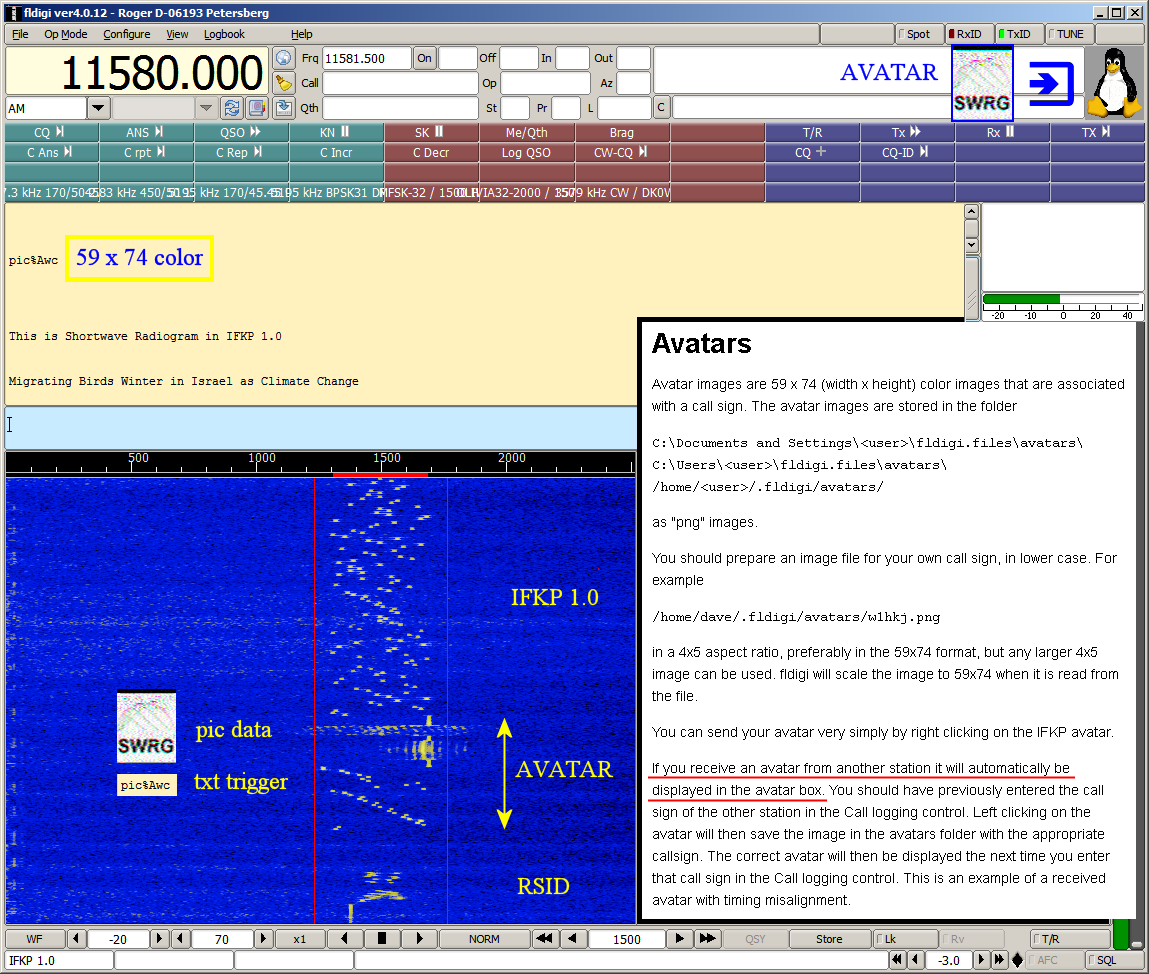
pic%Awc
This is Shortwave Radiogram in IFKP 1.0
Migrating Birds Winter in Israel as Climate Change Makes Desert
Too Dangerous
Reuters via voanews.com
27 November 2017
AGAMON HULA, ISRAEL - Climate change is turning
Israel into a
permanent wintering ground for some of the 500 million migrating
birds that used to stop over briefly before flying on to the warm
plains of Africa, Israeli experts s..
The birds now prefer to stay longer in cooler areas rather than
cross into Africa, where encroaching deserts and frequent
droughts have made food more scarce.
"In the last few decades Israel has become more than just a short
stopover because many more birds and a greater number of species
can no longer cross the desert," said ornithologist Shay Agmon,
avian coordinator for the wetlands park of Agamon Hula in
northern Israel.
"They will stay here for longer and eventually the whole pattern
of migration will change," he said.
Cranes are one of the most abundant species to visit the Hula
wetlands and Agmon said that the number that prefer to stay in
Israel until the end of March has risen from less than 1,000 in
the 1950s to some 45,000 currently.
Although migrating birds are a welcome attraction for
ornithologists and tourists, their hunger
for food from crop
fields makes them a menace to farmers. ...
Full text:
http://bit.ly/2AorUzS
pic%S
Please send reception reports to
radiogram@verizon.net
Shortwave Radiogram now returns to MFSK16 ...
RSID: <<2017-12-03T23:57Z
MFSK-16
@ 11580000+1500>>
Transmission of this special edition of Shortwave Radiogram is
provided by:
WRMI, Radio Miami International, http://wrmi.net
Please send reception reports to radiogram@verizon.net
And visit http://swradiogram.net
Twitter:
@SWRadiogram
I'm Kim Elliott. Please join us for the next Shortwave
Radiogram.
|
Ending song:
A Filetta - Tambour Battant
|
http://www.rhci-online.net/radiogram/radiogram.htm
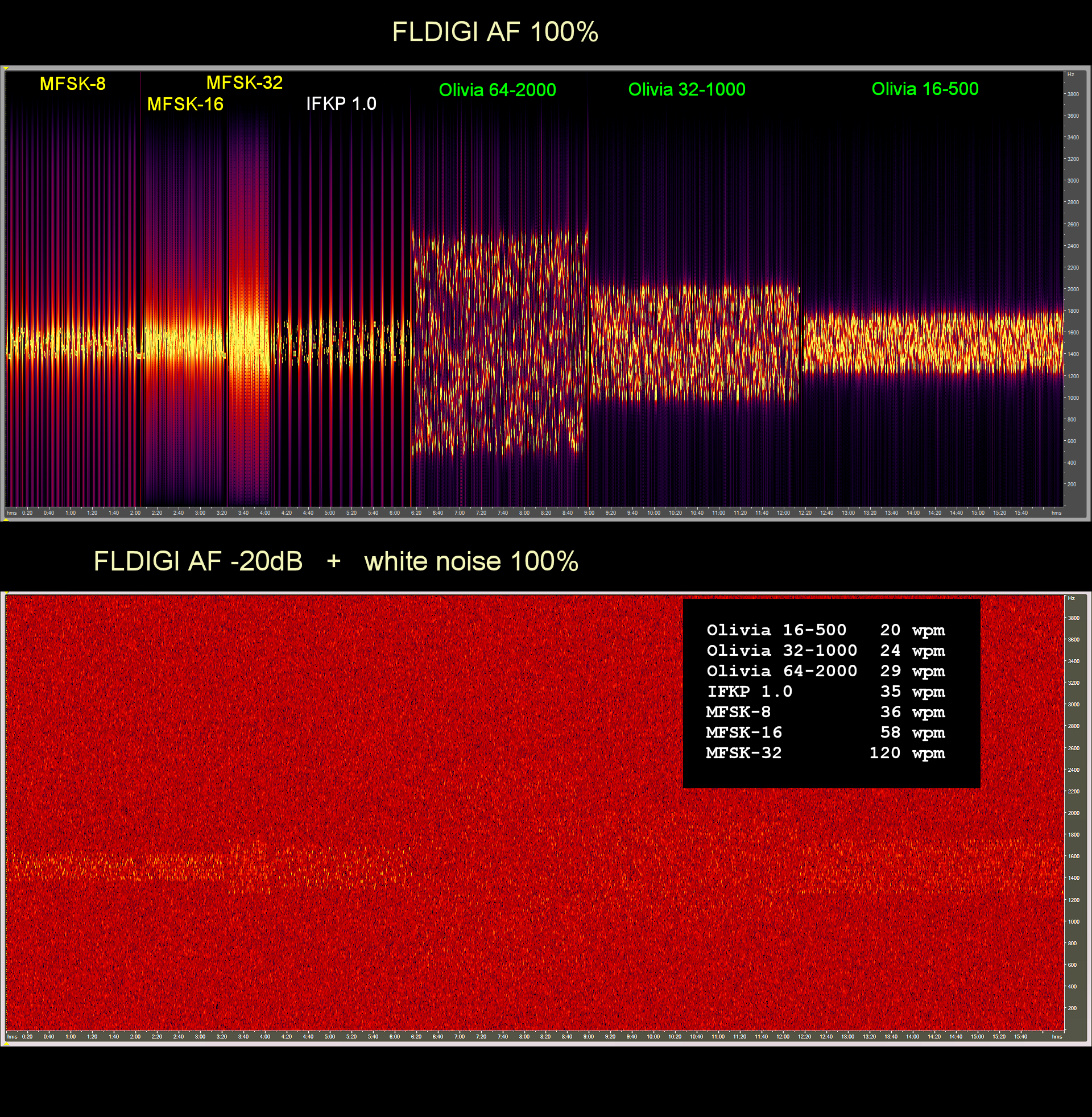
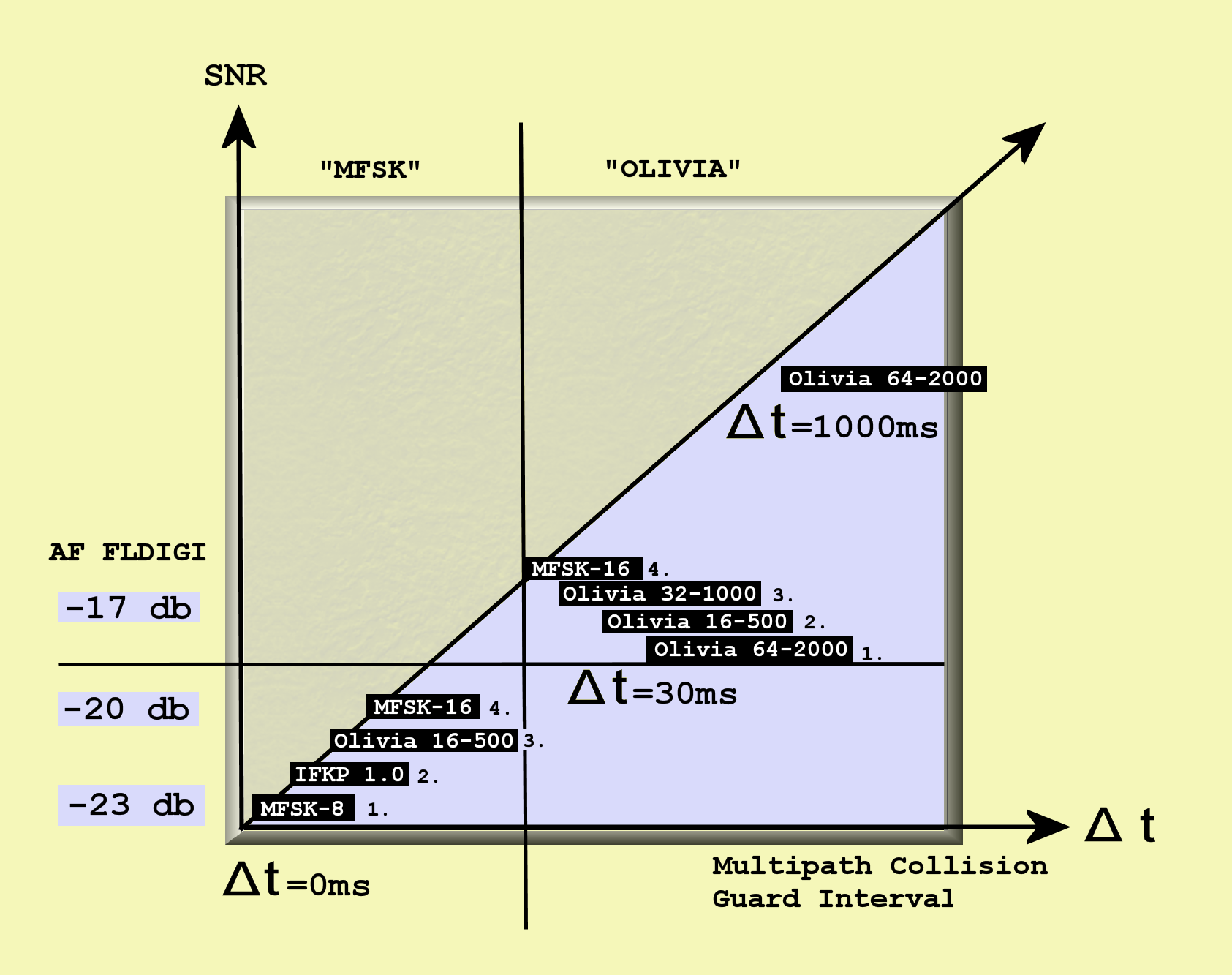
|
Fldigi-Audio -20db
+ White Noise 100%
RSID: MFSK-8 @ 1500>>
Test in MFSK-008 Test in MFSK-008 Test in MFSK-008 Test in MFSK-008 Test in
MFSK-008 Test in MFSK-008 Test in MFSK-008 Test in MFSK-008 Test in MFSK-008
Test in MFSK-008
Test in MFSK-008 Test in MFSK-008 Test in MFSK-008 Test in MFSK-008 Test in
MFSK-008 Test in MFSK-008 Test in MFSK-008 Test in MFSK-008 Test in MFSK-008
Test in MFSK-008
RSID: MFSK-16 @ 1500>>
FSK-016 Test in MFSK-016 Test in MFSK-016 Test in MFSK-016 Test in MFSK-016
Test in MFSK-016 Test in MFSK-016 Test in MFSK-016 Test in MFSK-016 Test in
MFSK-016
Test in MFSK-016 Test in MFSK-016 Test in MFSK-016 Test in MFSK-016 Test in
MFSK-016 Test in MFSK-016 Test in MFSK-016 Test in MFSK-016 Test in MFSK-016
Test in MFSK-016
RSID: MFSK-32 @ 1500>>
Test in MFSK-032 Test in MFSK-tptS m in MFSK-032 Test in MFSK-032 Test>n"src
2 =t eeMF o t¼ d nest in MFSK-032 TebtØbG.2 Test in MFS6-dÈ2 Test in
MFSK-032
lhst in MQ qerph32 Test nn xg nti j32e st in MFSK-032 Test in MFSK-032 Test
in MFSK-032 Test in MFSK-032 Test in MFSK-032 Test in MFSK-032 Test in
MFSK-032 Test in MFSK-032
RSID: IFKP 1.0 @ 1500>>
==================================================
Audit log: 20171208, 150454
==================================================
Test in IFKP 1.0 Test in IFKP 1.0 Test in IFKP 1.0 Test in IFKP 1.0 Test in
IFKP 1.0 Test in IFKP 1.0 Test in IFKP 1.0 Test in IFKP 1.0 Test in IFKP 1.0
Test in IFKP 1.0<LF>
Test in IFKP 1.0 Test in IFKP 1.0 Test in IFKP 1.0 Test in IFKP 1.0 Test in
IFKP 1.0 Test in IFKP 1.0 Test in IFKP 1.0 Test in IFKP 1.0 Test in IFKP 1.0
Test in IFKP 1.0<LF>
RSID: OL 64-2K @ 1500>>
OLI IA-2U-20B0qTl;l&!n OLI:Iv-64w2000UTesy Un OkIVIA264-00 %UsIai})IVIA\-20v
qest ii' z|]A-64-2000 Test in L VHAe7/-0_0 ;est>n jCUVI-64LM000 T st i2
OMI`IA-64-20)0 Tes6me#+ IVI# 64-2:0/ Test i/P IV A-64-2100
Tes} in OXIVIA-64-2r0 TestHin B *KIA-64-2J . Tesh in LIVIA--2000 Test &n5Vb
I7-64-20Ac Test iU O\IVYA-64-200 Tes inROLaVIA-64-2g<b[Temt#in OL
VIA-64-2n00 ue t in OLI88 -64-2000 Testain OLIVIA-64-2200 Te/t in
RSID: OL 32-1K @ 1500>>
MbAa/ TyA &est in OLIV>A-32-1000 Test in OLIVIA-32-|000:\est in
0LIVIA-32-1000 Test in OLIVIA-32-1000 Tet in OPIVIA-32-1000 Test in
OLIVIA-32-1000 Te Q in OLIVIA-32-1M0W Test in OLIVIA-32-10 N Tjst in
zLIVIA-32-1000 T>st in OLIVIA- 2-1000
Nest in OLIVIA-32-y000 Test in OLIVIA-32-1000 4 st in OLIVIA-32-1000 Test in
OLIVI-32-1000 Tesq xn OLIVIA-3-1000 Test in OLIVIA-3c-1000 Test in
OLIVIA-32-1000 Test in OLIVIA-32-1 0 Test in I IA-32-1000 Test WnxOLIVI
RSID: OL 16-500 @ 1500>>
Test in OLIVIA-16-0500 Test in OLIVIA-16-0500 Test in OLIVIA-16-0500 Test in
OLIVIA-16-0500 Test in OLIVIA-16-0500 Test in OLIVIA-16-0500 Test in
OLIVIA-16-0500 Test in OLIVIA-16-0500 Test in OLIVIA-16-0500 Test in
OLIVIA-16-0500
Test in OLIVIA-16-0500 Test in OLIVIA-16-0T00 Test in OLIVIA-16-0500 Test in
OLIVIA-16-0500 Test in OLIVIA-16-0500 Test in OLIVIA-16-0500 Test in
OLIVIA-16-0500 Test in OLIVIA-16-0500 Test in OLIVIA-16-0500 Test in
OLIVIA-16-0500
|
|
Fldigi-Audio -23db
+ White Noise 100%
iOo³e q±l a97De wt in MFSK-008 Test in MFSK-008 Test in MFSK-008 Test in
MFSK-008 Test in MFSK-008 Test in MFSK-008 Test in MFSK-008 Test in MFSK-008
Test in MFSK-008 Test in MFSK-008U±Test in MFSK-008 Test in MFSK-008 Test in
MFSK-008 Test in MFSK-008 Test in
MFSK-008 Test in MFSK-008 Test in MFSK-008 TesIeaewFSK-008 Test in MFSK-008
Test in MFSK-008
==================================================
Audit log: 20171208, 154810
==================================================
hnufIfHP 1.0 Test in IFKP 1.0 Tid.wmlspaivqt arszhinqzywyylcwFtHivlaaa[cyad<DEL>tBTest
in IFKP 1.0 Test in IFKP 1.0 Test inufIfHP 1.0 Test in IFKP 1.0 Test in
IFKP.0 Test in IFKP 1.0 Test in IFKP 1.m zaTest in IFKP 1.0 Test in IFKP
alq.0 Test in IFKP 1.0<LF>
Test in IFKP 1.0 Test in IfHP 1.0 Test in fFKP 1ay0 Test in vSfHP 1.0 Test
in IFK 1.0 Test in IFKP 1.0 Test in ±FKP 1.f3 Test in IFkxdP 1.0 Test in
IcKP 1.0 Test in IFKP 1.h<LF>
fp[atb
|
|
Get your official
Shortwave Radiogram white laboratory coats ready for a busy weekend
of experiments, 9-10 December 2017.
There was no
consensus as to whether the MFSK16 or MFSK8 was more successful last
weekend. (You
can listen to, and decode, the MFSK8 from 3 December as received
– with difficulty – in Tasmania.
This was during the 2330-2400 UTC
broadcast on 11580 kHz from WRMI Florida.) The IFKP 1.0 did not
decode for most listeners (including me), but there were some
successes, including the image.
This IFKP 1.0 image was decoded by
Richard in New Brunswick …
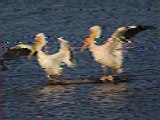
This weekend, we
will keep you busy for one more intensive round of radio
experiments, before settling down to some leisurely all-MFSK32
shows during the holiday period.
Three Olivia
modes on the 2330 UTC broadcast.
Let’s hope that propagation cooperates by providing poor reception
during the Sunday 2330-2400 broadcast on 11580 kHz.
During this
half hour, we will transmit Olivia 64-2000, Olivia 32-1000, and
Olivia 16-500, all centered on 1500 Hz. These are all slow modes,
between 20 and 30 wpm, so the entire broadcast will consist of
less than one AP news story.
Be sure to turn the Fldigi squelch
(SQL) off.
23:30:00 Music/voice introduction
Fun with Flamp.
Meanwhile, the other three broadcasts this weekend will be in the
usual MFSK32. There will, however, be one item in
8PSK-1000F, the very fast mode (3386 wpm) we tried a few weeks
ago.
This time, the 8PSK-1000F will be used in conjunction with
Flamp, one of the Fldigi suite of programs. Please download
Flamp from
https://sourceforge.net/projects/fldigi/files/flamp/ .
Flamp will divide
the news story into ten blocks of 480 bytes each. Then it will
transmit the story four times. Any blocks that do not have the
correct number of characters, due to fading or interference,
can
be received during the second, third, or fourth passes. The news
story that requires seven minutes to transmit in MFSK32 will be
transmitted four times in 8PSK-1000F in about one minute.
Please activate
Flamp before the switch to 8PSK-1000F at about 19:30 into the
show. Flamp will not turn on automatically (unless you have
configured Fldigi’s Autostart). Go to Flamp’s Receive
window.
Flamp will show you which blocks were received correctly during
the first through fourth passes.
If the file is
received 100%, click Save, then go to File > Folders > rx > [date
of reception] – then open the file SWRG25_Russia_media.txt.
Here is the
lineup for Shortwave Radiogram, program 25,
9-10 December 2017, all in MFSK32 except where noted:
2:56 French engineer creates biodegradable plastic*
10:18 Russia Declares RFE/RL, VOA 'Foreign Agents'*
19:30 8PSK-1000F with Flamp: same as preceding story **
20:40 MFSK32: Christmas markets in Germany*
26:36 Closing announcements
** Use with Flamp
(see above)
Shortwave Radiogram
Transmission Schedule
|
|
|
|
|
|
|
|
|
|
|
|
|
|
|
|
|
|
|
|
|
|
|
|
|
|
|
|
|
The Mighty KBC
transmits to Europe Saturdays at 1500-1600 UTC on 9400 kHz (via
Bulgaria), with the minute of MFSK at about 1530 UTC (if you are
outside of Europe, listen via
websdr.ewi.utwente.nl:8901/
).
And to North America Sundays at 0000-0200 UTC (Saturday 7-9 pm
EST) on 5960 kHz, via Germany. The minute of MFSK is at about 0130
UTC.
Reports to Eric:
themightykbc@gmail.com
. See also
http://www.kbcradio.eu/
and
https://www.facebook.com/TheMightyKbc/.
Italian Broadcasting Corporation (IBC)
For the complete IBC transmission schedule visit
http://ibcradio.webs.com/
Five minutes of MFSK32 is at the end of the 30-minute
English-language “Shortwave Panorama,” per the schedule below:
Thanks for your
reception reports!
Kim Andrew
Elliott, KD9XB
|



